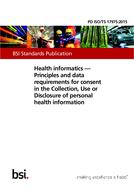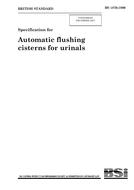
BS PD ISO/TS 17975:2015
Click here to purchase
BS PD ISO/TS 17975:2015 defines the set of frameworks of consent for the Collection, Use and/or Disclosure of personal information by health care practitioners or organizations that are frequently used to obtain agreement to process the personal health information of subjects of care. This is inorder to provide an Informational Consent framework which can be specified and used by individual policy domains (e.g. healthcare organizations, regional health authorities, jurisdictions, countries) as an aid to the consistent management of information in the delivery of health care services and the communication of electronic health records across organizational and jurisdictional boundaries.
The scope of application of this Technical Specification is limited to Personal Health Information (PHI)as defined in ISO 27799, “information about an identifiable person that relates to the physical or mental health of the individual, or to provision of health services to the individual. This information might include:
- information about the registration of the individual for the provision of health services;
- information about payments or eligibility for health care in respect to the individual;
- a number, symbol or particular code assigned to an individual to uniquely identify the individual for health purposes;
- any information about the individual that is collected in the course of the provision of health services to the individual;
- information derived from the testing or examination of a body part or bodily substance;
- identification of a person, e.g. a health professional, as a provider of healthcare to the individual.”
Good practice requirements are specified for each framework of Informational Consent. Adherence to these requirements is intended to ensure any subject of care and any parties that process personal health information that their agreement to do so has been properly obtained and correctly specified.
The Technical Specification is intended to be used to inform:
- discussion of national or jurisdictional Informational Consent policies;
- ways in which individuals and the public are informed about how personal health information isprocessed within organizations providing health services and health systems;
- how to judge the adequacy of the information provided when seeking Informational Consent;
- design of both paper and electronic Informational Consent declaration forms;
- design of those portions of electronic privacy policy services and security services that regulateaccess to personal health data;
- working practices of organizations and personnel who obtain or comply with consent for processingpersonal health information.
The Technical Specification does not:
- address the granting of consent to the delivery of healthcare-related treatment and care. Consent to the delivery of care or treatment has its own specific requirements, and is distinct from Informational Consent. Note that as Consent to Treatment and Care are outside the scope of this Technical Specification, the phrase “informational consent” is hereafter supplanted by the shorter “consent”. In every case, it is Informational Consent that is intended;
- specify any jurisdiction’s legal requirements or regulations relating to consent. The focus is on frameworks, not on jurisdictional legislation or its adequacy in any given jurisdiction. While care has been taken to design the frameworks so that they do not conflict with the legislation in mostjurisdictions, they might challenge some existing practices. This Technical Specification uses an approach that allows organizations or jurisdictions to select a subset of those frameworks whichbest fit their law culture and approach to data sharing;
- specify what consent framework is to be applied to a data classification or data purpose as this mayvary according to law or policy, although some examples of implementation profiles are provided inan informative Annex;
- determine the legal adequacy of the information upon which the consent is based or possible legalconsequences of inadequate information;
- specify the data format used when consent status is communicated. The focus is on the informationcharacteristics of consent, and not the technology or medium in which the characteristics areinstantiated;
- specify how individuals giving Informed Consent come to be informed of the responsibilities, obligations and consequences related to granting consent;
- specify how individuals are to be informed of the specifics of the data, data sharing or data processing concerned;
- specify how consent itself or the specific activities of the consent process are to be recorded; only that they be recorded. Specific requirements on recording consent in EHR systems are given in ISO/TS 14441, 5.3.2;
- specify any information security requirements (e.g. the use of encryption or specific forms of user authentication) as these are the subject of other standards (e.g. ISO 27799).
Cross References:
ISO/TS 14265:2011
ISO 7498-2:1989
ISO/IEC 10181-3:1996
ISO 13606-4:2008
ISO/TS 14441:2013
ISO/TS 21298:2008
ISO 22600:2014
ISO 22857:2013
ISO/TS 25237:2008
ISO 27799:2008
All current amendments available at time of purchase are included with the purchase of this document.
Product Details
- Published:
- 10/31/2015
- ISBN(s):
- 9780580797200
- Number of Pages:
- 46
- File Size:
- 1 file , 2.2 MB
- Same As:
- ISO/TS 17975:2015
- Product Code(s):
- 30266983, 30266983, 30266983
- Note:
- This product is unavailable in United Kingdom

